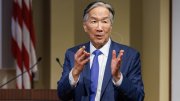The percentage of first-year Black students matriculating at Harvard College declined for a second consecutive year in the wake of new, court-driven admissions policies, while the percentage of Asian American students has increased, according to demographic figures for the Class of 2029 released on Thursday. Meanwhile, international student enrollment at the College remains steady, despite the Trump administration’s multipronged efforts to impose travel restrictions on foreign students and faculty.
According to data shared by the College, 1,675 students from 50 U.S. states and 92 countries make up the class of 2029, which arrived on campus this fall. Of those students, 11.5 percent self-identified as African American or Black, compared to 14 percent in the class of 2028.
The percentage of students identifying as Hispanic or Latino also declined compared to the class of 2028, to 11 percent from 16 percent. Forty-one percent of students identified as Asian American—a notable increase from 37 percent in the class of 2028 and 29.9 percent in the class of 2027, the last class admitted before the nationwide ban on affirmative action. Eight percent of the class chose not to report their race or ethnicity. Students who self-identified as more than one race were counted in the percentages of each of their chosen categories. Harvard did not release a figure for students categorized as white.
After the 2023 Supreme Court ruling in Students for Fair Admissions v. Harvard, which barred race-conscious college admissions, the University does not consider race or ethnicity in its review of applications. However, students can choose to self-report their race, with racial demographics made available after the admissions process is complete.
Forty-five percent of students in the new class will not pay any tuition to attend Harvard, thanks to a significant expansion in undergraduate financial aid announced this spring. Under the new policy, students with family incomes of $100,000 or below attend the College free of charge, and students with family incomes of $200,000 or below receive free tuition. Harvard’s annual financial aid budget, according to University figures, is $275 million.
Among the class of 2029, 21 percent of students are estimated by the University to be eligible for federal Pell grants (similar to 20.6 percent in the class of 2028). First-generation students make up 20 percent of the class.
“Even amid shifting economic realities, our commitment to access and opportunity remains unwavering,” said Dean of the Faculty of Arts and Sciences Hopi Hoekstra in a statement accompanying the class of 2029 data. “That nearly half of this class will attend Harvard tuition-free fills me with immense pride and optimism for the future they will help shape.”
Amid widespread concerns about international students’ ability to return to campus this fall, 90.3 percent of international students offered a spot in the class of 2029 accepted, “with only eight choosing to defer their admission,” according to Harvard’s press release. International students make up 15 percent of the class, a small decline from 16 percent in the class of 2028.
“All students no matter where they’re from, where they went to high school, or what their personal circumstances might be, were admitted to Harvard because they share the extraordinary potential to change the world,” said William Fitzsimmons, the dean of admissions and financial aid, in the press release.
The class of 2029 was the first cohort since the COVID-19 pandemic required to submit SAT or ACT test scores after the Faculty of Arts and Sciences reinstated mandatory testing in the spring of 2024. As a result, College officials said, Harvard saw an anticipated decrease in the total number of applicants, receiving 47,893 applications for the class of 2029, compared to 54,008 for the class of 2028 and 56,937 for the class of 2027.
With 2,003 students admitted, this year’s acceptance rate was 4.2 percent. The yield rate—the percentage of students who accepted the admissions offer and enrolled at Harvard—was 83.6 percent, consistent with the past several years.
Research led by Harvard faculty, which confirmed the role of standardized testing in helping predict students’ college success, was part of the motivation for reinstating the practice, according to the College’s Frequently Asked Questions page. “In Harvard’s whole-person review process, testing is just one data point among many considered carefully with the expertise of the admissions committee,” the page says.
Harvard also released figures about the intended field of study of first-year students. According to admissions data, 12.1 percent of the class of 2029 plans to concentrate in the humanities; 25.2 percent in engineering; 26.7 percent in the natural sciences; and 34.5 percent in social sciences, with the remainder undecided or planning special concentrations.
The release of data about the makeup of the College Class of 2029 comes amid reports of drastic cuts elsewhere in the Faculty of Arts and Sciences. The FAS plans to reduce the number of Ph.D. admissions slots by 75 percent in the science division and by 60 percent in the arts and humanities division, according to emails obtained by The Crimson. The official deadline for departments to inform the FAS about how they wish to allocate admissions spots for the next two years is this Friday.
UPDATE (10/27/25): The “Harvard College Class Makeup, by Race and Ethnicity” chart was updated to reflect the correct percentage of students in the class of 2029 who self-identified as Native American, Native Hawaiian, or Pacific Islander.









